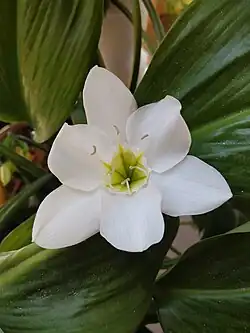Urceolina × grandiflora
| Urceolina × grandiflora | |
|---|---|

| |
| The illustration of Urceolina × grandiflora in the original publication. The green lines below the staminal cup are filamental traces along the perianth tube. | |
| Scientific classification | |
| Kingdom: | Plantae |
| Clade: | Tracheophytes |
| Clade: | Angiosperms |
| Clade: | Monocots |
| Order: | Asparagales |
| Family: | Amaryllidaceae |
| Subfamily: | Amaryllidoideae |
| Genus: | Urceolina |
| Species: | U. × grandiflora
|
| Binomial name | |
| Urceolina × grandiflora | |
| Synonyms[1] | |
| |
Urceolina × grandiflora, formerly known as Eucharis × grandiflora, is a natural hybrid putatively between U. moorei and U. sanderi of the family Amaryllidaceae, native to western Colombia and western Ecuador.[1]
The aneutriploid species U. amazonica is often misidentified as U. × grandiflora. Both of them are sterile plants with large fragrant white flowers, but they differ in leaf length, free filament shape, and staminal cup length:[2]
- U. × grandiflora has shorter leaf blades (20–33 cm × (10–)13–16 cm), linear or narrowly subulate free filaments (1–1.5 mm wide at the base), and staminal cups (5–7 mm long to the apex of teeth) shorter than free filaments (7–8.5(–10) mm long).
- U. amazonica has longer leaf blades ((20–)30–40(–50) cm × (10–)12–18 cm), subulate free filaments (2.8–3.4 mm wide at the base), and staminal cups (11.2–13.8 mm long to the apex of teeth) longer than free filaments (6.5–8(–10) mm long).
-
 U. × grandiflora has shorter leaf blades, slender free filaments, and staminal cups shorter than free filaments.
U. × grandiflora has shorter leaf blades, slender free filaments, and staminal cups shorter than free filaments. -
 U. amazonica has longer leaf blades, flat free filaments, and staminal cups longer than free filaments.
U. amazonica has longer leaf blades, flat free filaments, and staminal cups longer than free filaments. -
 Flower of U. × grandiflora
Flower of U. × grandiflora -
 Flower of U. amazonica
Flower of U. amazonica
References
- ^ a b "Urceolina × grandiflora (Planch. & Linden) Traub". Plants of the World Online. Kew Science. Retrieved 2023-06-28.
- ^ Meerow, Alan W. (1989). "Systematics of the Amazon lilies, Eucharis and Caliphruria (Amaryllidaceae)". Annals of the Missouri Botanical Garden. 76 (1): 136–220. Bibcode:1989AnMBG..76..136M. doi:10.2307/2399347. ISSN 0026-6493. JSTOR 2399347.